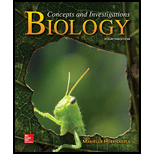
Concept explainers
Which of the following is NOT a similarity between land plants and green algae?
- a. Photosynthesis
- b. Starch as a storage form of energy
- c. Cellulose cell walls
- d. The presence of a cuticle and stomata
Introduction:
Green algae are the closest relatives of plants, some plants are also called charophytes. Both share most of the common features, they both are multicellular, they have cellulose cell wall and show photosynthesis.
Answer to Problem 1MCQ
Correct answer:
The stomata and cuticle are the adaptions of plants. Therefore, option d. is correct.
Explanation of Solution
Reason for the correct statement:
The plants can obtain and conserve resources by the stomata and cuticle. Plants can exchange gases through stomata. A cuticle is a lining of wax which makes water and gases impermeable to leaves. So, both stomata and cuticle are not present in green algae; they have cellulose and photosynthetic pigments.
Option d. is given as “The presence of a cuticle and stomata”.
As, “The presence of a cuticle and stomata is not a similarity between land plants and green algae”, is the right answer.
Hence, the option d. is correct.
Reasons for the incorrect statements:
Option a. is given as “Photosynthesis”.
The plants carry photosynthesis with the help of photosynthetic pigments CO2, water and minerals. The same photosynthetic pigments are present in green algae. This answer does not support the statement. So, it is a wrong answer.
Option b. is given as “Starch as a storage form of energy”.
Starch is present in both plants as well as in green algae and used as a nutrient reserve. This answer does not support the statement. So, it is a wrong answer.
Option c. is given as “Cellulose cell walls”.
The cellulose-rich cell walls are present in both green algae as well as in land plants. This answer does not support the statement. So, it is a wrong answer.
Hence, options a., b., and c. are incorrect.
The stomata and cuticle waxy linings are only present in land plants. The stomata opening is for the respiration and cuticle is an adaption in plants to protect the plant from water.
Want to see more full solutions like this?
Chapter 19 Solutions
Biology: Concepts and Investigations
Additional Science Textbook Solutions
Chemistry
Genetics: From Genes to Genomes
Chemistry: An Introduction to General, Organic, and Biological Chemistry (13th Edition)
Campbell Essential Biology (7th Edition)
- Find out about the organisations and the movements aimed at the conservation of our natural resources. Eg Chipko movement and Greenpeace. Make a project report on such an organisation.arrow_forwardWhat are biofertilizers and mention the significancearrow_forwardPCBs and River Otters: Otters in Washington State’s Green-Duwamish River have high levels of polychlorinated biphenyls (PCBs) in their livers. PCBs can bind to the estrogen receptors in animals and disrupt the endocrine system of these otters. The PCBs seem to increase the estrogen to androgen ratio, skewing the ratio toward too much estrogen. How would increased estrogen affect the river otter population? Based on your reading of the materials in this unit, what factors can affect fertility in humans? Explain how each of the factors affecting human fertility that you described can disrupt the human endocrine system to affect reproduction.arrow_forward
- Other than oil and alcohol, are there other liquids you could compare to water (that are liquid at room temperature)? How is water unique compared to these other liquids? What follow-up experiment would you like to do, and how would you relate it to your life?arrow_forwardSelection of Traits What adaptations do scavengers have for locating and feeding on prey? What adaptations do predators have for capturing and consuming prey?arrow_forwardCompetition Between Species What natural processes limit populations from growing too large? What are some resources organisms can compete over in their natural habitat?arrow_forward
- Species Interactions Explain how predators, prey and scavengers interact. Explain whether predators and scavengers are necessary or beneficial for an ecosystem.arrow_forwardmagine that you are conducting research on fruit type and seed dispersal. You submitted a paper to a peer-reviewed journal that addresses the factors that impact fruit type and seed dispersal mechanisms in plants of Central America. The editor of the journal communicates that your paper may be published if you make ‘minor revisions’ to the document. Describe two characteristics that you would expect in seeds that are dispersed by the wind. Contrast this with what you would expect for seeds that are gathered, buried or eaten by animals, and explain why they are different. (Editor’s note: Providing this information in your discussion will help readers to consider the significance of the research).arrow_forwardWhat is the difference between Uniporters, Symporters and Antiporters? Which of these are examples of active transport?arrow_forward
 Concepts of BiologyBiologyISBN:9781938168116Author:Samantha Fowler, Rebecca Roush, James WisePublisher:OpenStax College
Concepts of BiologyBiologyISBN:9781938168116Author:Samantha Fowler, Rebecca Roush, James WisePublisher:OpenStax College Biology (MindTap Course List)BiologyISBN:9781337392938Author:Eldra Solomon, Charles Martin, Diana W. Martin, Linda R. BergPublisher:Cengage Learning
Biology (MindTap Course List)BiologyISBN:9781337392938Author:Eldra Solomon, Charles Martin, Diana W. Martin, Linda R. BergPublisher:Cengage Learning
 Biology: The Dynamic Science (MindTap Course List)BiologyISBN:9781305389892Author:Peter J. Russell, Paul E. Hertz, Beverly McMillanPublisher:Cengage Learning
Biology: The Dynamic Science (MindTap Course List)BiologyISBN:9781305389892Author:Peter J. Russell, Paul E. Hertz, Beverly McMillanPublisher:Cengage Learning Biology 2eBiologyISBN:9781947172517Author:Matthew Douglas, Jung Choi, Mary Ann ClarkPublisher:OpenStax
Biology 2eBiologyISBN:9781947172517Author:Matthew Douglas, Jung Choi, Mary Ann ClarkPublisher:OpenStax





